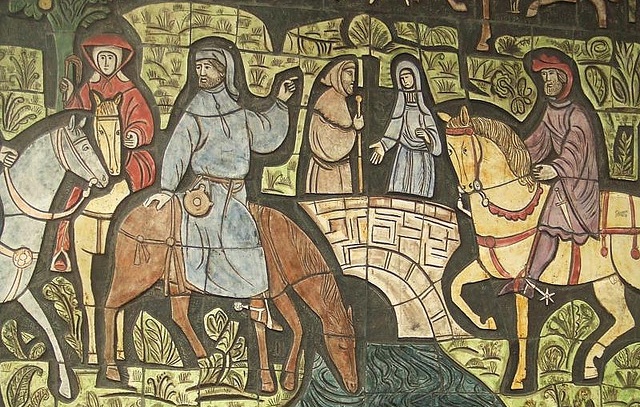
The picture is of a mural on the Old Kent Road showing Chaucer's Pilgrims refreshing their horses in a tributary of the River Peck (photo credit Matt Brown).
This blog by Nicola Bacon was first posted on the blog oldkentroadfuture.
We often find that places that thrive do so because of their sense of history and their strong identity, the sense of place that enables people to feel at home. Places also work best when residents feel they belong, when they feel at home – regardless of their different backgrounds, ages, or life circumstances.
The Old Kent Road is a part of Southwark with a rich and distinctive history – from the Romans onwards. It is one of the most diverse roads in south London, bordering both leafy green parks and industrial estates, and used as residential, industrial and retail space. Most south Londoners know it as a traffic artery, or as a useful place to shop. For some it is a difficult, polluted street but for many it the place they have lived for years, or where they trade and run successful businesses. For the people who live there, who call it home, its distinctive identity, both positive and negative, is a fundamental part of what makes it home.
When agencies start thinking about improving or regenerating local areas they usually think first about the physical environment, the streets and the housing, how space is used, and what should be built. They tend to think less about how people live and feel about the area. But the social fabric is as important as the buildings, and plans to improve areas need to focus on residents’ everyday experiences – both those who live in the area now and the people who will be there in the future – recognising what supports local quality of life.
Last summer Social Life spent some days talking to traders at the Elephant & Castle shopping centre, which is round the corner from our office. We saw how traders support the local economy and local communities in many ways, as independent family businesses employing local people with long-established customers, as a supportive local business community and through informal support networks that reach across the city and the globe. Our report of this work can be downloaded here.
South London is changing rapidly and many people are nervous about what this means for them, particularly if they are on low incomes and are anxious about their housing costs, or the security of their home. When plans for local areas take as their starting point what is working in an area now (as well as what is going less well) there is a better chance that the plans will be sustainable in the long term.
Residents living on or around the Old Kent Road will have strong view about their neighbourhood and what sort of change they want to see. A process is starting now to develop a new area plan. This needs to identify where there are local strengths and assets, like the good services, local shops or cafes that are meeting places for the local community and the centre of support networks; where neighbours know each other well and are helping each other get by; where people meet and come together. It’s important to identify what makes people feel good about the area as well as what feels more negative – and often these things aren’t obvious to agencies or outsiders.
Social Life has put together a social sustainability framework to help think about what makes places thrive. All of our work is about the relationship between people and the places they live in, because we believe that this an essential factor in creating neighbourhoods that work for everyone.
South London is changing rapidly and many people are nervous about what this means for them, particularly if they are on low incomes and are anxious about their housing costs, or the security of their home.